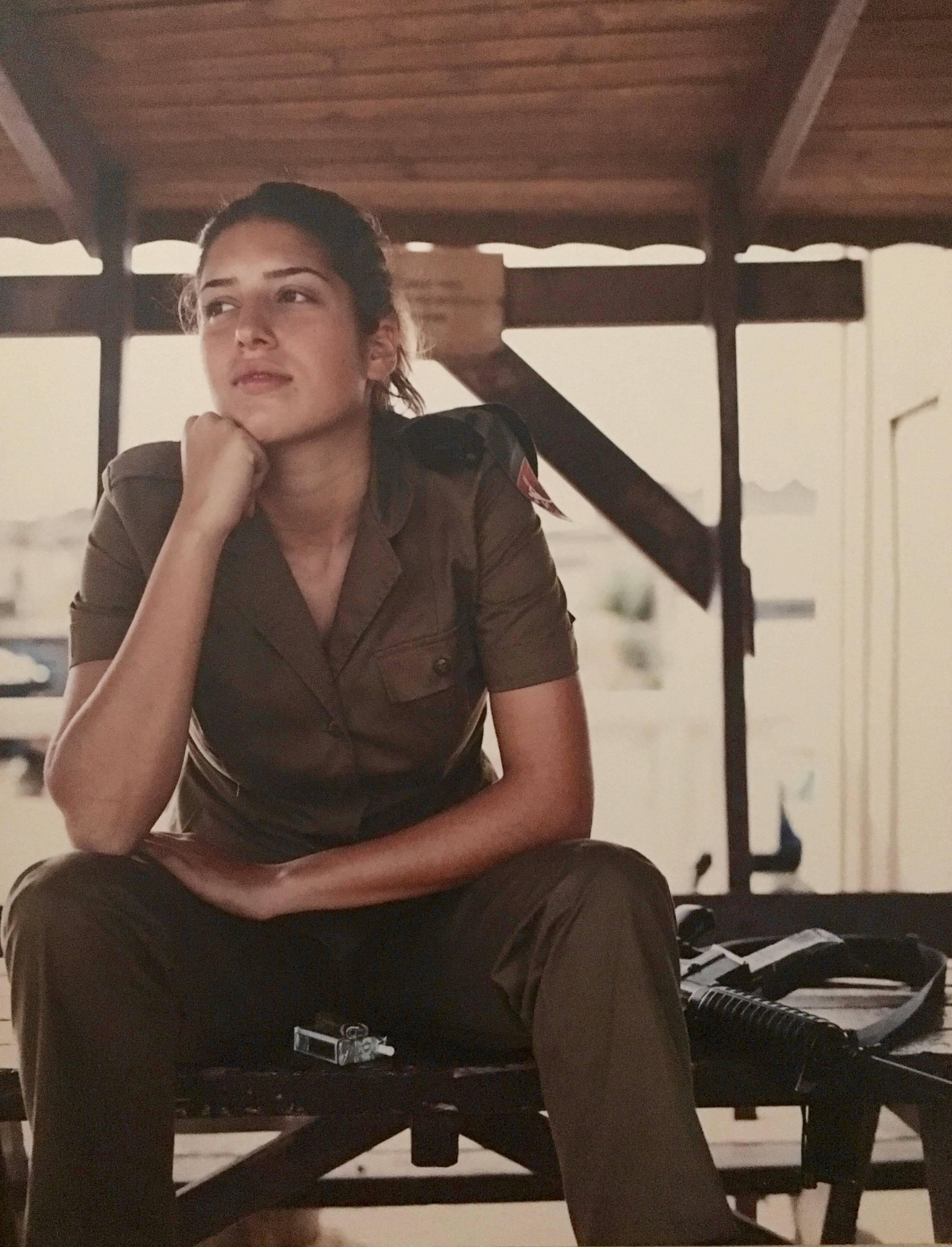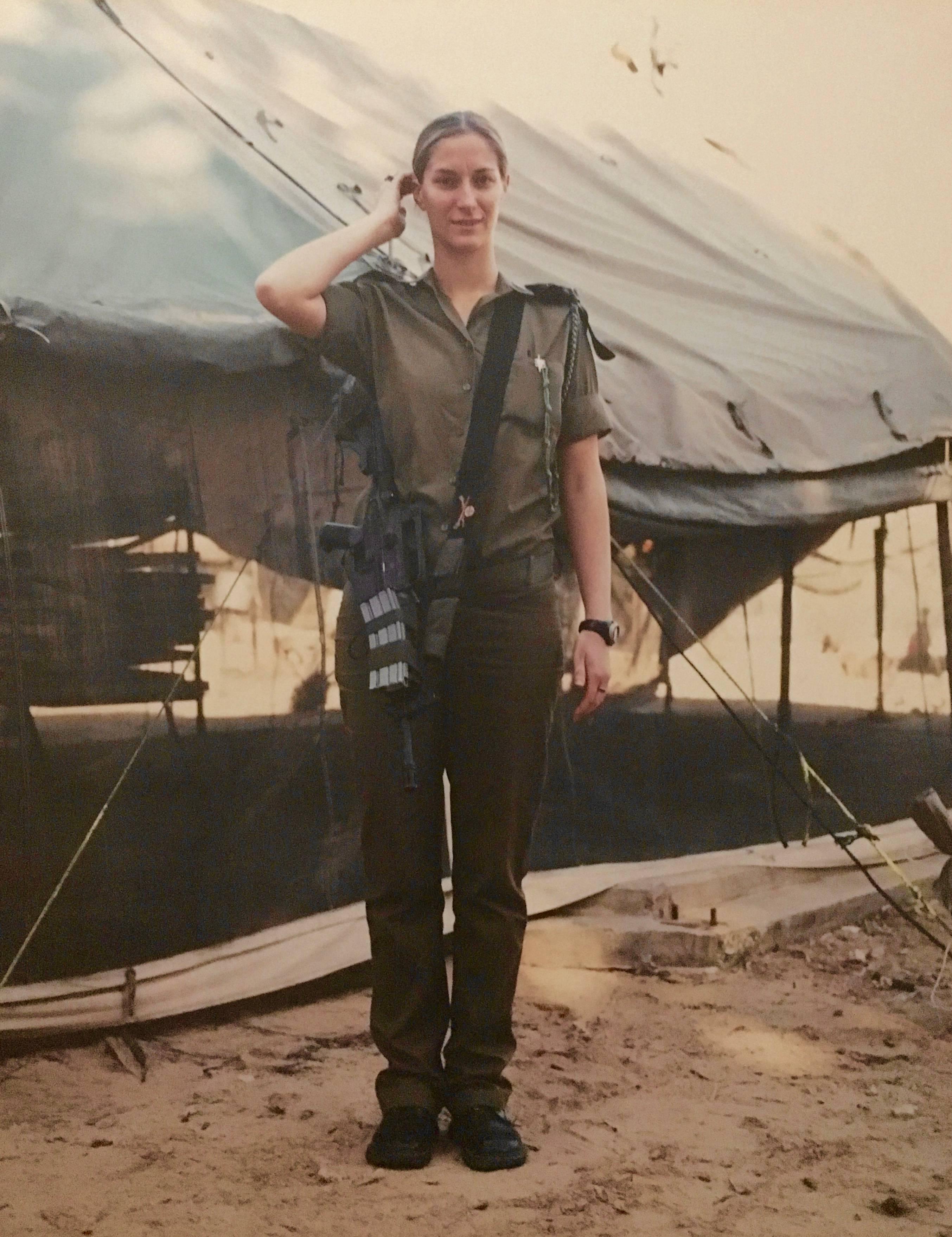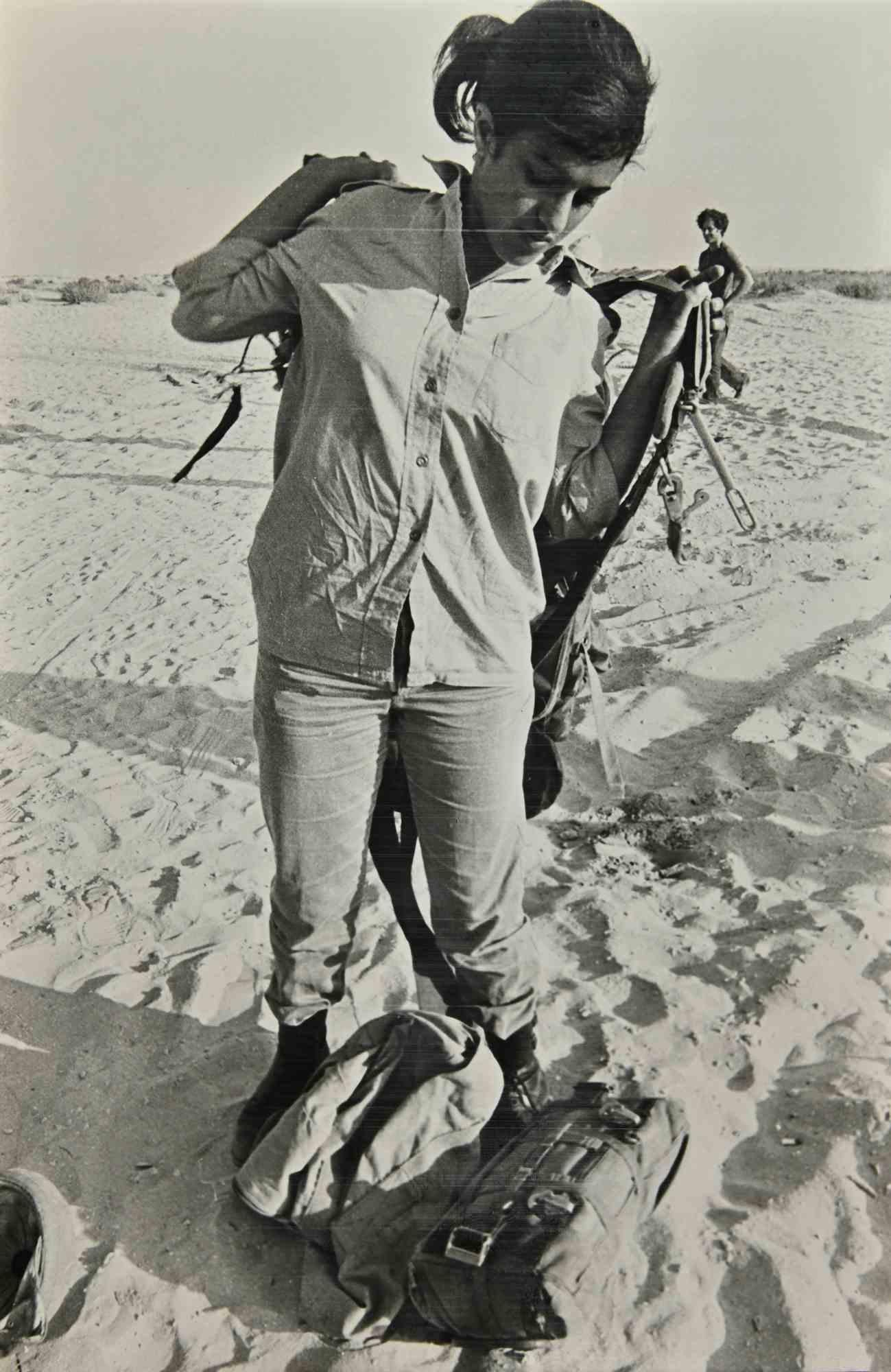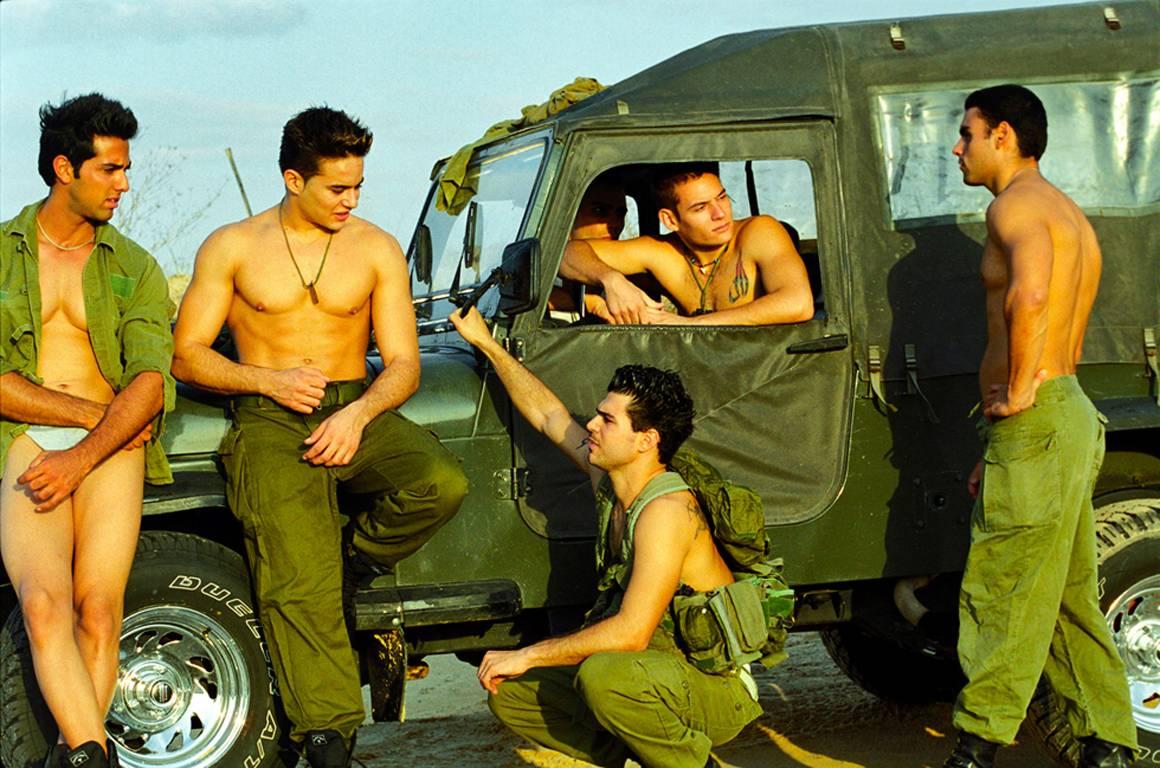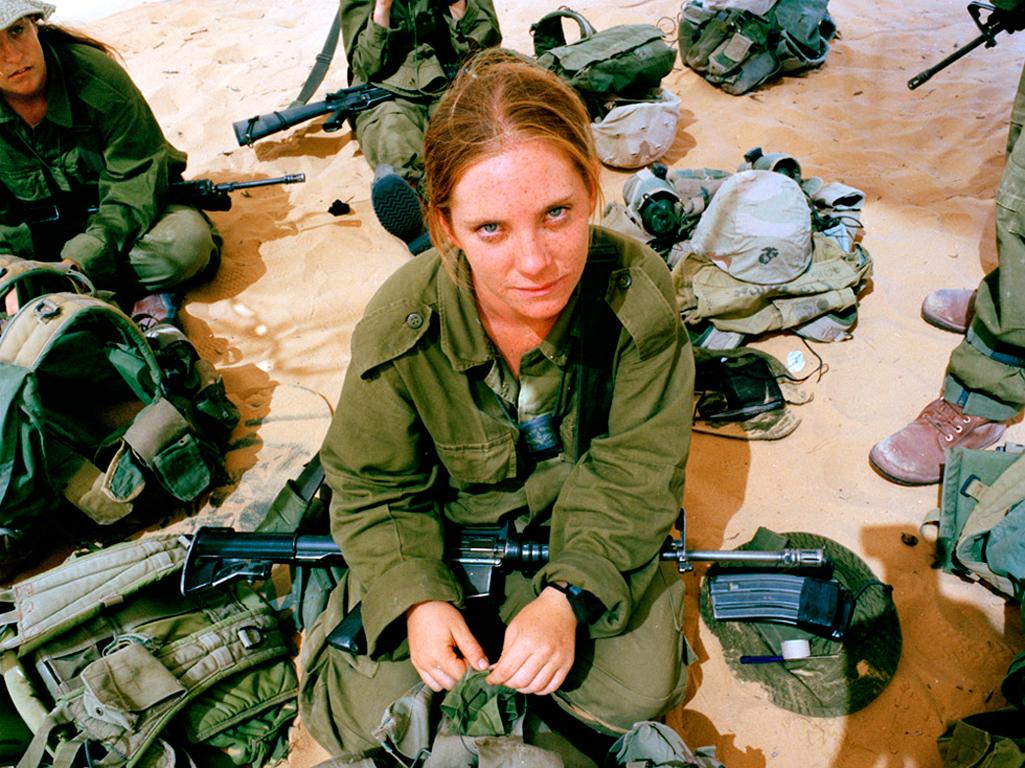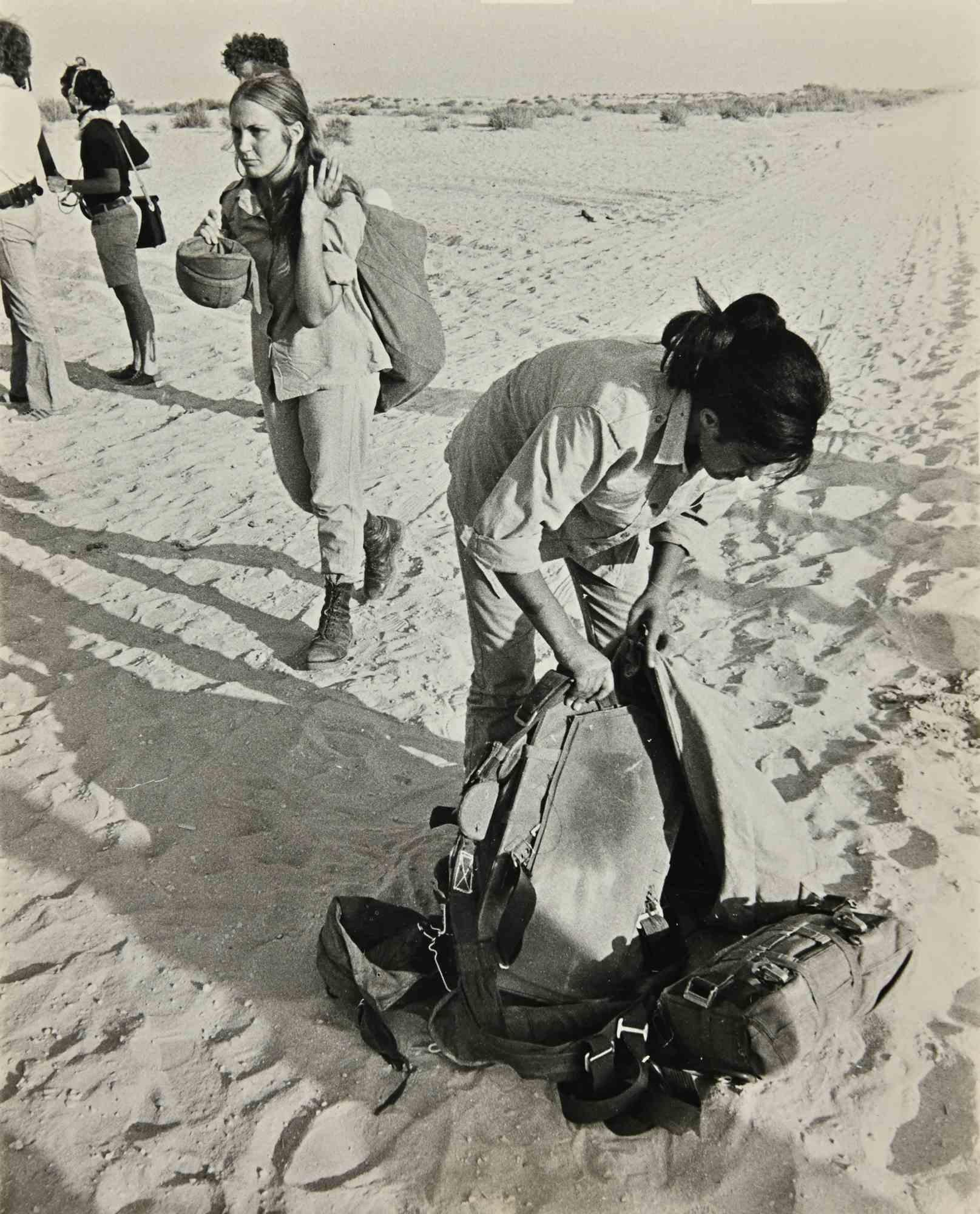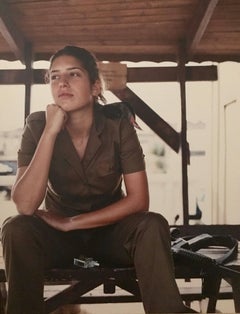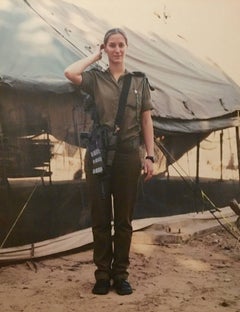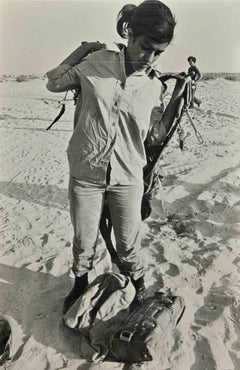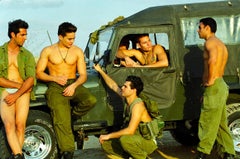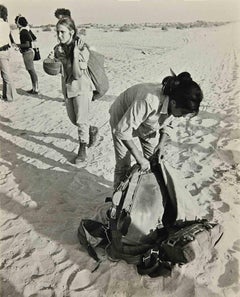Items Similar to WOMEN OF THE IDF Large color Photograph LITAL
Want more images or videos?
Request additional images or videos from the seller
1 of 8
Ashkan SahihiWOMEN OF THE IDF Large color Photograph LITAL
$1,800
£1,376.20
€1,585.10
CA$2,522.35
A$2,815.97
CHF 1,475.53
MX$34,470.22
NOK 18,739.19
SEK 17,668.67
DKK 11,829.76
Shipping
Retrieving quote...The 1stDibs Promise:
Authenticity Guarantee,
Money-Back Guarantee,
24-Hour Cancellation
About the Item
"Women of the IDF" Large Exhibition color Photograph
30 x 40 inches, mounted on masonite and laminated.
Edition of 4 + 2 artists proof. minor dings and bumps to edges Born in Tehran, Iran, Ashkan Sahihi moved with his family to West Germany at the age of seven. Although he began taking photographs as a teenager, Sahihi traces the beginning of his professional trajectory to New York in 1987, a thriving “pop culture metropolis” where he could do the kind of photography work that he wanted to do, exploring the underbelly of the society around him. Taking assignments from German publications such as the Süddeutsche Zeitung Magazine, Der Spiegel, Dummy and GEO, he photographed subjects like prisoners on death row, players in the hip-hop scene, and the downtown art scene of New York. Neither black nor white, an insider among outsiders, he found himself able to navigate spaces and dynamics that others might have had difficulty entering. He considered this both a privilege and an obligation – to visit these places and tell these stories. His success led to commissions from American publications as well, including the New York Times Magazine, the New Yorker, Rolling Stone, and Vogue.
Put off by the limitations of photojournalism (the expectation that he would illustrate the writer’s perspective rather than author a narrative of his own), Sahihi began to embark on independent, highly compact conceptual series. His main goal in these series has been to drive forward public discourse on topics he believes have not provoked enough or the right kind of discussion: drugs, gender in the media, women in the military, etc. His portraits draw on a familiar visual language – often seated subjects before a neutral backdrop – but push the viewer to feel and think about entirely new things. Although he constantly challenges the comfort level of both the viewer and the subject, Sahihi never removes himself from the line of fire; all of his work requires the artist to immerse himself in uncomfortable situations and challenge his own emotional fortitude.
Photographic Series
In the “Face Series”, latex-gloved hands manipulate the subjects’ features, stretching, pushing, squeezing, pinching at the whim of external direction – from the artist? The customer? The public? The “Hypnosis Series” comprises 8 portraits of hypnotized subjects each experiencing a single emotion, e.g. helplessness, withholding/anger, or regret. In a society that rewards the suppression of such naked emotion, the purity of these depictions is arresting.
In 2006, Sahihi photographed himself in the homes and with the families of six ex-girlfriends and one ex-wife, imposing himself more or less awkwardly on the constellations that emerged after he had exited their lives (“Exes Series”).
For Sahihi’s most well-known work, the “Drug Series,” he convinced 11 non–drug users to consume a particular drug, then took their portraits over the course of their trips. The series was born out of Sahihi’s frustration with the hypocrisy of the political conversation about drugs in the United States. “By attempting to present an objective image of drug use, the artist addresses the cultural politics that allow our society to simultaneously glamorize the ‘drug look’ in fashion magazines and the entertainment industry and meanwhile turn a blind eye to the complicated, and vast, problem of drug abuse.” Sahihi has exhibited this series at MoMA PS1 New York in 2001, in Dresden in 2008, and alongside his installation “100 Million in Ready Cash."
Sahihi’s dense explorations through small photographic series include “Women of the IDF," portraits of female Israeli soldiers; “Camp X-Ray Guantanamo Bay,” black-and-white landscapes of barbed wire and watch towers; the “Cum Series”; the “Armpit Series”; and the “Kiss Series," in which the artist photographed himself kissing 18 women and men of various ethnicities. Sahihi’s photographs of the Occupy Wall Street movement constitute his latest series of this kind.
In recent years, Sahihi has lived and worked in New York, Istanbul, the Middle East, and London, producing bodies of work in each place that attempt to engage the political discourse he deems lacking in substance.
Exhibitions
Andrea Rosen Gallery, NY, USA (2000)
Basel Art Fair 31, Switzerland (2000)
MoMA PS1, NY, USA (solo and group shows, 2001 and 2006)
John Connelly Presents, NY, USA
Akureyri Museum, Iceland
Akademie der Künste, Berlin, Germany
Axel Raben Gallery, NY, USA
Macro, Rome, Italy
Schloss Morsbroich, Leverkusen, Germany
Städtische Galerie, Dresden, Germany
Galerie am Körnerpark, Berlin, Germany (2015)
Galerie Springer, Berlin, Germany (2015)
Kehrer Galerie, Berlin, Germany (2016)
- Creator:Ashkan Sahihi (1963, Iranian)
- Dimensions:Height: 40 in (101.6 cm)Width: 31 in (78.74 cm)Depth: 1 in (2.54 cm)
- Medium:
- Period:
- Condition:minor bumps and dings to edges.
- Gallery Location:Surfside, FL
- Reference Number:1stDibs: LU38211256702
About the Seller
4.9
Platinum Seller
Premium sellers with a 4.7+ rating and 24-hour response times
Established in 1995
1stDibs seller since 2014
1,784 sales on 1stDibs
Typical response time: <1 hour
- ShippingRetrieving quote...Shipping from: Surfside, FL
- Return Policy
Authenticity Guarantee
In the unlikely event there’s an issue with an item’s authenticity, contact us within 1 year for a full refund. DetailsMoney-Back Guarantee
If your item is not as described, is damaged in transit, or does not arrive, contact us within 7 days for a full refund. Details24-Hour Cancellation
You have a 24-hour grace period in which to reconsider your purchase, with no questions asked.Vetted Professional Sellers
Our world-class sellers must adhere to strict standards for service and quality, maintaining the integrity of our listings.Price-Match Guarantee
If you find that a seller listed the same item for a lower price elsewhere, we’ll match it.Trusted Global Delivery
Our best-in-class carrier network provides specialized shipping options worldwide, including custom delivery.More From This Seller
View AllLarge Color Photograph "Women of the IDF" Ashkan Sahihi
By Ashkan Sahihi
Located in Surfside, FL
"Women of the IDF" Large Exhibition color Photograph
30 x 40 inches, mounted on masonite and laminated.
Edition of 4 + 2 artists proof. minor dings and bumps to edges Born in Tehran, Iran, Ashkan Sahihi moved with his family to West Germany at the age of seven. Although he began taking photographs as a teenager, Sahihi traces the beginning of his professional trajectory to New York in 1987, a thriving “pop culture metropolis” where he could do the kind of photography work that he wanted to do, exploring the underbelly of the society around him. Taking assignments from German publications such as the Süddeutsche Zeitung Magazine, Der Spiegel, Dummy and GEO, he photographed subjects like prisoners on death row, players in the hip-hop scene, and the downtown art scene of New York. Neither black nor white, an insider among outsiders, he found himself able to navigate spaces and dynamics that others might have had difficulty entering. He considered this both a privilege and an obligation – to visit these places and tell these stories. His success led to commissions from American publications as well, including the New York Times Magazine, the New Yorker, Rolling Stone, and Vogue.
Put off by the limitations of photojournalism (the expectation that he would illustrate the writer’s perspective rather than author a narrative of his own), Sahihi began to embark on independent, highly compact conceptual series. His main goal in these series has been to drive forward public discourse on topics he believes have not provoked enough or the right kind of discussion: drugs, gender in the media, women in the military, etc. His portraits draw on a familiar visual language – often seated subjects before a neutral backdrop – but push the viewer to feel and think about entirely new things. Although he constantly challenges the comfort level of both the viewer and the subject, Sahihi never removes himself from the line of fire; all of his work requires the artist to immerse himself in uncomfortable situations and challenge his own emotional fortitude.
Photographic Series
In the “Face Series”, latex-gloved hands manipulate the subjects’ features, stretching, pushing, squeezing, pinching at the whim of external direction – from the artist? The customer? The public? The “Hypnosis Series” comprises 8 portraits of hypnotized subjects each experiencing a single emotion, e.g. helplessness, withholding/anger, or regret. In a society that rewards the suppression of such naked emotion, the purity of these depictions is arresting.
In 2006, Sahihi photographed himself in the homes and with the families of six ex-girlfriends and one ex-wife, imposing himself more or less awkwardly on the constellations that emerged after he had exited their lives (“Exes Series”).
For Sahihi’s most well-known work, the “Drug Series,” he convinced 11 non–drug users to consume a particular drug, then took their portraits over the course of their trips. The series was born out of Sahihi’s frustration with the hypocrisy of the political conversation about drugs in the United States. “By attempting to present an objective image of drug use, the artist addresses the cultural politics that allow our society to simultaneously glamorize the ‘drug look’ in fashion magazines and the entertainment industry and meanwhile turn a blind eye to the complicated, and vast, problem of drug abuse.” Sahihi has exhibited this series at MoMA PS1 New York in 2001, in Dresden in 2008, and alongside his installation “100 Million in Ready Cash."
Sahihi’s dense explorations through small photographic series include “Women of the IDF," portraits of female Israeli soldiers...
Category
Early 2000s Portrait Photography
Materials
Laminate, Masonite
WOMEN OF THE ISRAEL DEFENSE FORCES Large Photo NETA
By Ashkan Sahihi
Located in Surfside, FL
"Women of the IDF" Large Exhibition color Photograph
30 x 40 inches, mounted on masonite and laminated.
Edition of 4 + 2 artists proof. minor dings and bumps to edges Born in Tehran, Iran, Ashkan Sahihi moved with his family to West Germany at the age of seven. Although he began taking photographs as a teenager, Sahihi traces the beginning of his professional trajectory to New York in 1987, a thriving “pop culture metropolis” where he could do the kind of photography work that he wanted to do, exploring the underbelly of the society around him. Taking assignments from German publications such as the Süddeutsche Zeitung Magazine, Der Spiegel, Dummy and GEO, he photographed subjects like prisoners on death row, players in the hip-hop scene, and the downtown art scene of New York. Neither black nor white, an insider among outsiders, he found himself able to navigate spaces and dynamics that others might have had difficulty entering. He considered this both a privilege and an obligation – to visit these places and tell these stories. His success led to commissions from American publications as well, including the New York Times Magazine, the New Yorker, Rolling Stone, and Vogue.
Put off by the limitations of photojournalism (the expectation that he would illustrate the writer’s perspective rather than author a narrative of his own), Sahihi began to embark on independent, highly compact conceptual series. His main goal in these series has been to drive forward public discourse on topics he believes have not provoked enough or the right kind of discussion: drugs, gender in the media, women in the military, etc. His portraits draw on a familiar visual language – often seated subjects before a neutral backdrop – but push the viewer to feel and think about entirely new things. Although he constantly challenges the comfort level of both the viewer and the subject, Sahihi never removes himself from the line of fire; all of his work requires the artist to immerse himself in uncomfortable situations and challenge his own emotional fortitude.
Photographic Series
In the “Face Series”, latex-gloved hands manipulate the subjects’ features, stretching, pushing, squeezing, pinching at the whim of external direction – from the artist? The customer? The public? The “Hypnosis Series” comprises 8 portraits of hypnotized subjects each experiencing a single emotion, e.g. helplessness, withholding/anger, or regret. In a society that rewards the suppression of such naked emotion, the purity of these depictions is arresting.
In 2006, Sahihi photographed himself in the homes and with the families of six ex-girlfriends and one ex-wife, imposing himself more or less awkwardly on the constellations that emerged after he had exited their lives (“Exes Series”).
For Sahihi’s most well-known work, the “Drug Series,” he convinced 11 non–drug users to consume a particular drug, then took their portraits over the course of their trips. The series was born out of Sahihi’s frustration with the hypocrisy of the political conversation about drugs in the United States. “By attempting to present an objective image of drug use, the artist addresses the cultural politics that allow our society to simultaneously glamorize the ‘drug look’ in fashion magazines and the entertainment industry and meanwhile turn a blind eye to the complicated, and vast, problem of drug abuse.” Sahihi has exhibited this series at MoMA PS1 New York in 2001, in Dresden in 2008, and alongside his installation “100 Million in Ready Cash."
Sahihi’s dense explorations through small photographic series include “Women of the IDF," portraits of female Israeli soldiers...
Category
Early 2000s Portrait Photography
Materials
Masonite
Colored Photograph Of Nerturei Karta Children Playing
Located in Surfside, FL
Neturei Karta (Jewish Babylonian Aramaic: נָטוֹרֵי קַרְתָּא nāṭōrē qarṯā, literally "Guardians of the City") is a religious group of Haredi Jews, formally created in Jerusalem, Briti...
Category
Late 20th Century Color Photography
Materials
Photographic Paper
Shmita Mitah, Large Scale Contemporary Israeli Photograph Modern Judaica Photo
By Ken Goldman
Located in Surfside, FL
Contemporary Jewish artist Ken Goldman, born: 1960, Memphis Tenn.
Education: Pratt Institute, Masters of industrial Design, 1985
Brooklyn College, B.A Fine Arts, 1981
Made Aliyah: 19...
Category
21st Century and Contemporary Contemporary Landscape Photography
Materials
Digital
Vintage Color Photograph Nun, Mount Olives, Jerusalem Museum Ted Spiegel Photo
Located in Surfside, FL
This is a vintage Ted Spiegel photo of a Benedictine Nun, Mount of Olives, Jerusalem. Hand signed and editioned A/P.
This is for one Photograph from the portfolio entitled "Jerusalem: City of Mankind," The mounting is 14 X 17 inches. the actual photo measurement is between 9.25 X 14 to 10.5 X 13.5 inches (22.9 X 35.6 to 26.7 X 34.3 cm.) This is hand signed and editioned in pencil, on print mount recto; and stamped on the reverse with photographers name and copyright info. In a folding jacket with a printed credit and title. The red title sheet is just here for provenance and reference and is not included in this sale.
The first copy was awarded to the President of the United States, the second to the President of the State of Israel, the third to the Mayor of Jerusalem and the fourth to the Baron Edmond de Rothschild. Rare Cornell Capa and Baron Edmond De Rothschild “Jerusalem: City Of Mankind” Photo Album 1973. It has been produced by the international fund for concerned photography, INC, New York for the women’s division of the American Friends of the Israel Museum, New York.
15 copied were reserved for participating photographers.
Color prints are made by dye transfer process from original transparencies and black and white enlargements are made from original negatives under the photographers supervision.
Design and production – Arnold Skolnick / Bhupendra Karia.
Color prints by Berkey K & L Custom Services INC, New York.
Black and white prints by Igor Bakht
Werner Braun – Moonrise over the Knesset
Robert Burroughs – At the Western Wall.
Cornell Capa – View from the Israel Museum sculpture garden.
Leonard Freed – Reading from Sephardic Torah scrolls.
Ernst Haas – In the Arab quarter, Old City.
Charles Harbutt – Easter, Holy fire.
Ron Havilio – Wallscape.
Bhupendra Karia – Midday prayers, Al Aqsa grounds.
Marc Riboud – Ecumenical landscape Billy rose garden, Israel museum.
Ted Spiegel – Benedictine nun, Mount of Olives.
Micha Bar-Am – Via Dolorosa on Friday.
An accomplished photojournalist with more than 50 years of experience, Ted Spiegel has
covered assignments across the globe, but like the 19th-century artists of the famed Hudson
River School, he's made the Hudson River Valley the focus of much of his life's work.
Spiegel's love of the landscape and positive attitude infuse all his images. His January 1978 assignment for National Geographic magazine was a color photo essay on the Hudson River Valley. He has produced 15 other photo essays for National Geographic magazine on a variety of subjects, and has also produced several picture books on such topics as the Hudson River Valley, Saratoga and West Point. He also did a celebrated series of photos of John F Kennedy one of which was selected for the JFK USA postal stamp.
Speigel’s biography on the National Geographic website espouses his zest for his home: “He’s covered assignments across the globe, but like the 19th-century artists of the famed Hudson River School, he’s made the Hudson River Valley the focus of much of his life’s work.”
It also notes that he uses photography as a medium to encourage appreciation and respect for the environment’s beauty: “Spiegel’s love of the landscape and positive attitude infuse all his images, [and he] sees his landscape photography as a way to make people aware of the beauty in nature and a way to, in turn, encourage people to help protect and save the environment.” Photographers, like seeds in a rich environment, take root, grow and prosper. For Ansel Adams, the place was the West Coast -- Carmel, Calif., and Yosemite National Park. For Ted Spiegel, it is the Hudson River Valley -- Bear Mountain...
Category
1970s Modern Color Photography
Materials
Photographic Paper, C Print, Color
Neil Folberg Impressionists Color Photo Hand Signed Pigment Print Photograph
By Neil Folberg
Located in Surfside, FL
Neil Folberg (b. 1950)
Travels with Van Gogh and the Impressionists, Lin Arison and Neil Folberg
Pigment print on rag paper
Ultrachrome K3 inks on Crane Museo Silver Rag archival fin...
Category
1980s Contemporary Color Photography
Materials
Photographic Paper, Color
You May Also Like
Israel's Parachute Girls - Vintage Photograph - 1970s
Located in Roma, IT
Israel's Parachute Girls is a vintage black and white Photograph realized in the 1970s.
Good conditions.
The description on the rear.
Category
1970s Contemporary Figurative Photography
Materials
Photographic Paper
Untitled (Soldiers No. 2)
By Kobi Israel
Located in New York, NY
Chromogenic print
Signed and numbered, verso
(Edition of 10)
This photograph is offered by ClampArt, located in New York City.
About the artist:
Born in 1970 in a suburb of Tel-Aviv...
Category
Early 2000s Contemporary Portrait Photography
Materials
C Print
After throwing a grenade for the first time
By Rachel Papo
Located in New York, NY
Chromogenic print
Signed, dated, and numbered, verso
20 x 24 inches
(Edition of 9)
30 x 40 inches
(Edition of 5)
This photograph is offered by ClampArt, located in New York City.
Please note that prices increase as editions sell.
At the age of eighteen, Israeli girls enter a two-year period in which they will be transformed from girls to women under the Israeli Defense Forces...
Category
Early 2000s Contemporary Portrait Photography
Materials
C Print
Israel's Parachute Girls - Vintage Photograph - 1970s
Located in Roma, IT
Israel's Parachute Girls is a vintage black and white Photograph realized in the 1970s.
Good conditions.
The description on the rear.
Category
1970s Contemporary Figurative Photography
Materials
Photographic Paper
Talking to family during a break from basic training
By Rachel Papo
Located in New York, NY
Chromogenic print
Signed, dated, and numbered, verso
20 x 24 inches
(Edition of 9)
30 x 40 inches
(Edition of 5)
This photograph is offered by ClampArt, located in New York City.
...
Category
Early 2000s Contemporary Portrait Photography
Materials
C Print
Christina Portrait Color Photography on Dibond with Perspex Front UV Resistant
By Billy & Hells
Located in Utrecht, NL
Christina Portrait Color Photography on Dibond with Perspex Front UV Resistant
Billy und Hells are two photographers: Anke Linz (Nürnberg, 1965) and Andreas Oettinger (Munich, 1963...
Category
21st Century and Contemporary Contemporary Color Photography
Materials
Lambda
More Ways To Browse
Minor White Photograph
Drug Pop Art
Israeli Soldier
Womens Gloves
John Glover
Watch Tower
Antonio Garcia Lopez
John Travolta
Autograph Photos
Bette Midler
Barbra Streisand Vintage
Truman Capote
Brigitte Bardot Pop Art
Winston Churchill Portrait
Frida Kahlo Photograph
Grace Coddington
Isabella Blow
Socialite Portrait Painting
